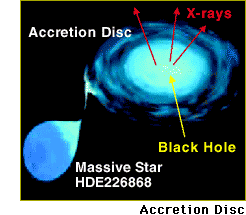With the aid of a "modulation collimator" (or a "bamboo screen collimator" in Japanese tongue), a device developed by Professor Oda, he and Dr. Shigenori Miyamoto (honorary professor, of the University of Osaka) determined the exact location of Cygnus X-1 and astronomer of all of the world searched that area with radio and optical telescopes. As a result, the star called HDE226868 emerged as a possible Cygnus X-1. Judging from its spectrum, it is a blue star whose mass is 30 times larger than that of the sun. At first glance, when observed through light alone, it seems to be just an ordinary star with large mass. But close examination led to the discovery that it is periodically twirled by a celestial body, in a regular pattern that repeats every 5.6 days. By observing the star's movement, astronomers calculated the weight of that mysterious celestial body. They estimated that it is an unusually compact star, at least six times heavier than the sun yet less than 300 km in diameter. Such a small but heavy star can be neither a neutron star nor a white dwarf, so the logical conclusion is that it is most likely a black hole. By around 1975, many had come to agree that Cygnus X-1 is a binary star comprised of HDE226868 and a black hole, and that strong X-rays are likely emitted when star gas is sucked into the black hole. Now we think that the mass of Cygnus X-1's black hole is ten times larger than that of the sun, and that a star whose mass was 30 times that of the sun was transformed into a black hole when a supernova explosion occurred at the end of its evolution.  There are probably many people here who are wondering how a black hole, which absorbs even light, can emit X-rays. Let me explain briefly. Gas absorbed by a black hole forms a flat disc, and falls into the black hole like the whirlpool that is formed when you unplug the drain in the bathtub. This is called an accretion disc. The inner part of the disc, which is located closer to the black hole, experiences a lot of friction. That makes it hotter than the outer part of the disc - as hot as 10 million degrees Celsius. And matter with such an elevated temperature emits X-rays. By comparison, the sun, with a much lower surface temperature of 6000 degrees Celsius, emits visible light, while the human body, with a temperature that is much lower still, emits infrared light, which has a longer wavelength and which activates sensors attached to such things as automatic doors. There are probably many people here who are wondering how a black hole, which absorbs even light, can emit X-rays. Let me explain briefly. Gas absorbed by a black hole forms a flat disc, and falls into the black hole like the whirlpool that is formed when you unplug the drain in the bathtub. This is called an accretion disc. The inner part of the disc, which is located closer to the black hole, experiences a lot of friction. That makes it hotter than the outer part of the disc - as hot as 10 million degrees Celsius. And matter with such an elevated temperature emits X-rays. By comparison, the sun, with a much lower surface temperature of 6000 degrees Celsius, emits visible light, while the human body, with a temperature that is much lower still, emits infrared light, which has a longer wavelength and which activates sensors attached to such things as automatic doors.Since X-rays are a kind of electromagnetic wave, they cannot escape from inside the event horizon, but they do manage to escape from the accretion disc, which is located just outside the horizon. We could say that X-rays are the last cry that gas gives just before falling into the back hole. |
||||||
|
||||||